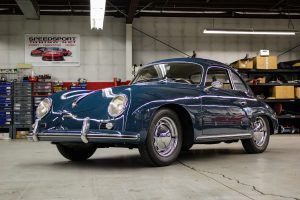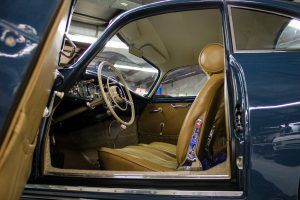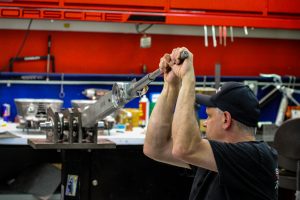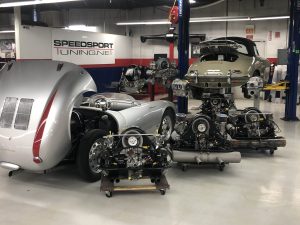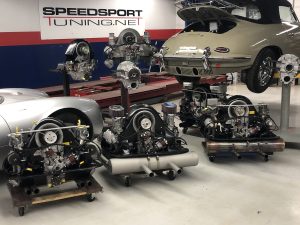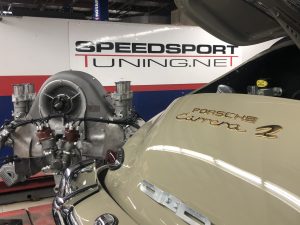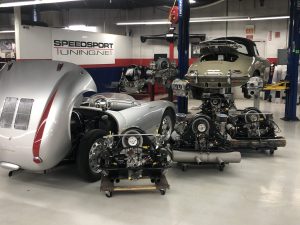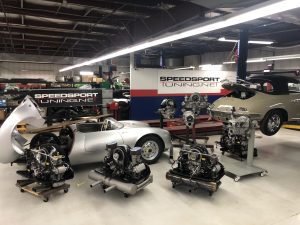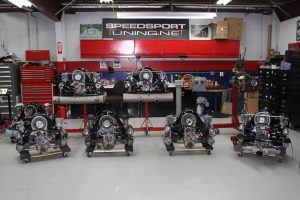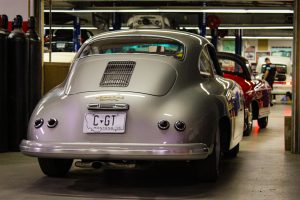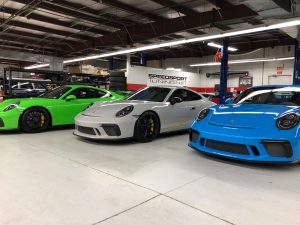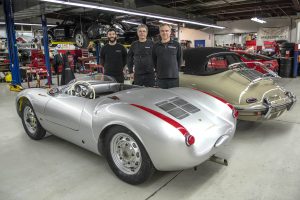Is 60 Horsepower Enough To Start A Porsche Career?
Jeff Adams of SpeedSport Tuning drove a 1958 356A Coupe with a four-cam 356 engine across the country. Little did he know that would be the start of an incredible career.
Vintage Porsche cars can be difficult to maintain, rebuild, and work on, especially if the car is powered by a unique engine that was only used in a small number of Porsche cars. During the early days of Porsche, a specialized engine appeared called the four-cam 356 engine. This engine is durable and made for racing, but is also overly complicated, which can be pretty typical of German engineering.
These engines ranged across three generations, fitting into Porsche cars starting in 1954 with production lasting until 1965. The four-cam 356 engine was made for racing, taking the Volkswagen approach to the next level. Eventually, this project was approved and a select number of Porsche cars were built with a 356 four-cam engine powering them.
This engine brought about the name Carrera, which is used for some Porche models today, but not in the same manner. Today, the original Carrera engine is rare and heavily sought after, which means someone needs to maintain and work on the cars powered by this engine. Many owners turn to Jeff Adams, who has become a legendary Porsche tuner and one of the few people in the world who can service and rebuild the rare four-cam 356 engines.
Jeff Adams: Porsche Four-Cam 356 Specialist
The age of the 356 four-cam engine, along with its rarity, makes working on these engines a bit of a lost art. Jeff learned the skill to restore, rebuild, and maintain these engines from Gerry McCarthy, who gained the original knowledge in the 1950 and attended a factory-hosted training session early in the production run for these engines.
This means Jeff learned the skill from someone with years of experience with these specialized and complicated engines, which means he has the knowledge to understand every iteration of these Porsche engines. This knowledge has been job security, because very few people in the world can actually work on the 356 four- cam engines.
How It Started
During Jeff’s junior year of high school, he and his dad flew to Seattle to pick up a vintage Porsche from his uncle. That car was a 1958 356A coupe that made 60 horsepower, which means the engine is among the first generation of these specialized models. The pair drove the car back to Hartford, Connecticut, and brought back stories from their trip.
As new Porsche 356 owners, Jeff discovered a local, unofficial, group of 356 enthusiasts that create a club called the Southern Connecticut 356 Register. Jeff and his parents joined this club and at a shop even he met Gerry McCarthy and asked for a job. The rest, as they say, is history.
Learning from the best
From the beginning at the shop, where he would wash cars and get breakfast, normal activities for the most junior member, Jeff eventually worked his way up to become McCarthy’s apprentice. Gerry was the local 356 guru and very few people could work on these complicated cars in the 1990s, and even few can today. This has allowed Jeff to become one of only a handful of people who has the knowledge to work on the 356 four-cam engines, which is a reason for anyone with this engine in their car to contact SpeedSport Tuning.
What Is A Four-Cam 356 Engine?
In the early days of Porsche, late 1940s and early 1950s, the company borrowed heavily from Volkswagen, which was Dr. Porsche’s creation. When he put his own name on the company, he wanted to create a performance-based lineup, and the 1100cc engine from the 1948 Beetle, which made 25 horsepower in the VW, was upgraded to produce 40 horsepower in a Porsche. This was a significant increase at the time, despite not amounting to much by modern standards.
The first 550 Spyder models arrived in 1953 with production versions appearing in 1954, which is also when they began racing. The four-cam 356 engines were originally made for racing, but some owners bought them to use on the street.
The Complicated Engine Design
Four-cam engines use a lot of gears to make the cams spin, instead of what’s found in a typical pushrod engine. There aren’t any belts or rods, but lots of gears. They use a roller bearing crankshaft, which is an assembled crankshaft that goes around the connecting rods.
These engines consist of a double overhead cam driven by gears with two spark plugs per cylinder, and a hemispherical chambers ( long before there was a Hemi engine for Plymouth). This setup allowed the engine to produce the desired power for endurance races, making these cars perfect for competition at Le Mans.
Rarity Becomes A Collector’s Dream
Like many vintage cars, the 356 four-cam Porsche models fell out of favor during much of the 1970s and 1980s. These cars weren’t old enough to be classics and the complicated engines made them headaches for many owners. Beginning in the 1990s, the cars became collectible, and a dream scenario took place. As collector’s began nabbing Porsche cars with these engines, a niche market formed, ensuring job security for Jeff.
Average Project Time?
When a SpeedSport Tuning customer needs a 356 four-cam engine rebuilt, Jeff quotes one year as the project time. If everything goes smoothly and the engine has very few miles on it, it’s possible to get the job done sooner, but a full year is typically how long these projects can take.
Most of these vintage engines have issues that aren’t typical, making each engine rebuild unique. This means some parts may have to be fabricated, but thankfully, many parts are available from Porsche and a few aftermarket companies.
When parts must be fabricated, an interesting conversation arises. The SpeedSport team has to figure out how many of each part to order, typically fabricators require parts be ordered in batches, and how to sell the extra parts. This can lead to desire to have ordered more parts, because other 356 four-cam owners will generally purchase the additional parts from them.
Oldest Four-Cam 356 Porsche Engine Jeff Rebuilt?
The oldest four-cam engine Jeff worked in is from late 1954, which makes it the first official production run of this engine. The engine was a prototype in 1953 and then produced he next year. Jeff worked on the engine and transmission from this original run.
No Such Thing As Blowing Up An Engine
During Jeff’s lengthy career an extensive experience with the Porsche four-cam engines, he has changed his answer to customers who worry about blowing up their engines. He informs them that engines won’t just blow up. If he can listen to the engine and put oil in it, the engine will likely be fine. They aren’t delicate or fragile.
Bryan Lagas, Owner of SpeedSport Tuning, mentioned that some customers will keep the original engine separate from the car when its being driven, and have a spare engine in the car. This allows them to maintain their concourse value of the car.
Jeff Shares His Knowledge
The expertise to rebuild 356 four-cam Porsche engines won’t end with Jeff Adams. He’s been working with another mechanic at SpeedSport Tuning for the past thirteen years to teach him how to work on these engines. That original knowledge from Gerry McCarthy will live on with the next generation of Porsche mechanics.


